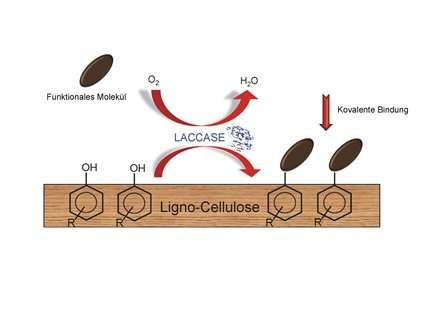Search engine for 'smart wood'

The enzyme laccase is able to alter the chemical structure of wood on its surface and thus facilitate biochemical modifications without changing the structure of the material. By attaching functional molecules, Empa researchers develop waterproof or antimicrobial wood surfaces, for instance. Also it is possible to make adhesive wood fibers, which can be pressed to fiberboards without any chemical binding agents. These solvent-free fiberboards are used for insulation of eco houses.
The problem: There are many variants of laccase, which differ in the architecture of the chemically active center, and not all of them react with the desired substrate. As it is extremely difficult to predict whether or not a particular laccase will react with a specific substrate, costly and time-consuming series of experiments are required to identify suitable laccase-substrate pairs. Molecular simulations could solve the problem: You simply need a precise structural analysis of the laccase to simulate the chemical reaction mechanism for every desirable combination on the computer. However, this requires a high computer computing—capacity and, even then, would be extremely time-consuming and expensive.
But there is a shortcut: "deep learning." A computer program is trained to recognize patterns with data from the literature and own experiments: Which laccase oxidizes which substrate? What might be the best conditions for the desired chemical process to take place? The best thing about it: The search works even if not all details about the chemical mechanism are known.

Major progress in the last seven years
The availability of the data in a suitable form and the architecture of the deep-learning network are crucial for this to succeed. Schubert has already been working with neuronal networks for over seven years. His first project on the topic stems from 2012, the latest from 2018. "In the past, we worked with shallow neuronal networks: an input layer, a hidden layer and an output layer. Today, we work with considerably more complex networks. They contain several hidden layers and are so much more powerful."
Schubert trains his algorithms with known datasets and tests them with datasets that the system has never seen before. And his reports on the robustness of his "smart wood search engine" are astonishing: In the past, he was only able to use carefully selected, meaningful data to achieve decent results. Meanwhile, he is also testing his systems with partly unusable data piles. The machine recognizes what it can use and what not.
Industrial application of KI
The system's robustness already enables the deep-learning machine to be used by industry. Self-adhesive insulation boards are produced at the partner company Pavatex, which Schubert has been working with for some time. The production process is full of sensors; enormous amounts of data accumulate that tell us "something" about the quality of the manufactured boards. Only what? Schubert's smart wood search engine finds the connection.
The researcher is currently working on optimizing the production in this way. If something goes awry at one point in the fiber processing, the production should be adjusted before the quality of the final product is affected. This saves costly checks on the end product and can slash the error rate in the production process.




















